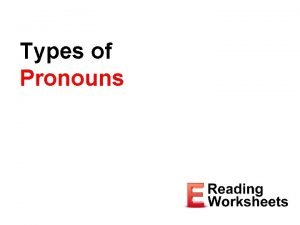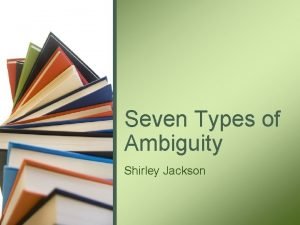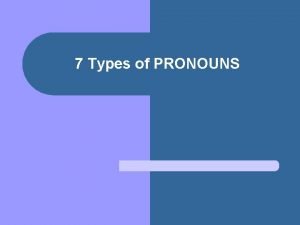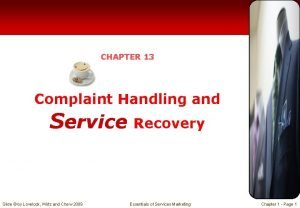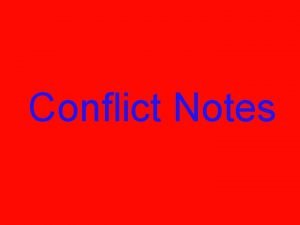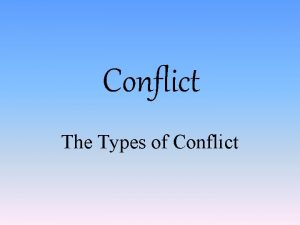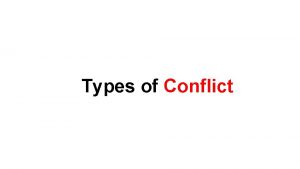Seven Types of Conflict SEVEN TYPES OF CONFLICT









- Slides: 9

Seven Types of Conflict

SEVEN TYPES OF CONFLICT • A preliminary step in resolving conflict is to understand what the conflict is actually about. Having a clear picture of what the issues are reduces the chance of a mismatch between the problem and the solution. In this section, we identify conflicts according to their core elements. Seven main types of conflict are discussed below: data conflicts, relationship conflicts, conflicts over values, conflicts regarding resources, conflicts about past history, conflicts about structure, and psychological conflicts. • Conflicts can be complex, and they may not always be about what they seem. For example, a disagreement that seems to be about data may actually have elements of relationship or values embedded within it. It's necessary to observe carefully to determine the true combination of elements that are involved.

Data There are conflicts which exist primarily over data or facts. Most data conflicts have data or factual solutions, either through obtaining more information or through new data collection. Example: Mother is convinced that her daughter can learn to read on grade level and accuses the school district of failing to provide appropriate instruction. However, two separate ability tests given several years ago place her daughter's IQ between the 2 nd and 5 th percentile, leading school personnel to believe that grade level performance is most likely unrealistic. Mother believes, for a number of reasons, that the test results are invalid. Discussion: Some methods of using data to help resolve the issue could include providing more information regarding the relationship of IQ to reading achievement, re-doing the ability test to meet mother's concerns about test validity, or devising a data-driven reading instructional plan and reading assessment strategy that everyone can agree on.

Relationship • Conflicts can arise over a relationship, or over a communication style. • Example: Father is upset because he believes that the special education teacher is not following up sufficiently on his child. He states that an agreement to provide weekly feedback regarding progress has not been reliably kept. Finally, he feels that the special education teacher is condescending and diffident in her dealings with him, often failing to return his phone calls the same day. • Discussion: Educational relationships can often be improved by clearly stating needs, developing clear expectations, and writing agreements down for the parties to follow. Many times people are unaware of how they come across to others. "You can't change if you aren't told what's wrong!"

Values • Conflicts can occur over values, where the parties have perceived or actual incompatibilities in their belief systems. • Example: Maryís teacher feels that Mary, a third grader, gains valuable social skills and modeling when she participates in problem-solving class meetings. Mary's mother feels that school is a time that Mary should be learning her math facts, particularly since she is behind. She wants Mary pulled out for individualized math instruction during class meeting time. • Discussion: Our values help us define what is right or wrong in any situation, and provide a moral compass for our lives. Different values do not need to cause conflict; people can live together in harmony with different value systems. The keys to successful resolution are improvement and expansion of tolerance, understanding, and acceptance of others points of view.

Resources • Conflicts often occur over real or perceived scarcity of resources: • Example: Beth is a student who requires assistive technology in order to communicate. Her parents feel strongly that she needs the latest in voice-generating computer technology in order to maximize progress on her IEP. This technology costs over $10, 000. The school district feels that Beth's IEP goals can be met by utilizing existing technology at a much lower cost. • Discussion: A key concept useful to work with when scarce resources are at stake is that of expanding the pie. Expanding the pie involves brainstorming ways to use existing resources more effectively. Perhaps the technology can be leased instead of bought; perhaps it can be shared. The possible solutions are limited only by the flexibility and creativity of those involved.

History • Conflicts occasionally result from a history of slights or bad blood between parents and schools. Sometimes the core of these conflicts goes clear back to when those parents were students themselves. • Example: John, a parent, has a great deal of difficulty communicating with the school, particularly when his child is in trouble. He comes to meetings stiffly, with his arms folded, and says little. Privately, he blames the school for picking on his child. John went to this school as a child and remembers his experience in mostly negative terms. • Discussion: In such cases, it’s most important to communicate person to person, to allow the person carrying the history a chance to vent and tell his story, to stay away from evoking rules as justification for decisions, • and to ultimately allow a new perspective to emerge overtime. • It's important to remember that histories weren't created overnight and usually won't be resolved overnight. Building trust takes time.

Structural • Conflicts can occur over how to deal with structural realities which exist outside the immediate world of the parent/school but which are having an impact on them. • Example: Vicki is a child with medical/emotional issues that sometimes require her mother's attention. School is not going well and frustration is mounting because mother must work and cannot come to school when she is needed and when she would like to. • Discussion: It can be helpful to assist those involved with this type of problem to appreciate the external forces and constraints bearing upon them. Their appreciation that a conflict has an external source can have the effect of everyone coming together to jointly address the imposed difficulties. Structural conflicts will often have structural solutions.

Psychological • Conflicts can be caused or maintained by the psychological needs of humans: the desire for power, control, autonomy, recognition or love. • Discussion: These conflicts are often difficult to identify and it is important that dispute resolvers not engage in excessive psychoanalyzing of others. Still, there are times when these basic human tendencies and drives will be contributing to a conflict, often masquerading as some other, more tangible issue. Few people are going to be able to come out and say "I'm in this conflict with you because you're not giving me enough recognition. " Sometimes it is wisest to not deal with these issues directly; people hate to feel as if they are being analyzed. If you become aware of these issues, it may be useful to search for a viable solution that will help some of these needs to actually be met, and will thereby reduce the need to create more conflict.
 Heavenly virtues and deadly sins
Heavenly virtues and deadly sins External conflict definition
External conflict definition What is conflict and conflict resolution?
What is conflict and conflict resolution? External and internal conflict definition
External and internal conflict definition This that are pronouns
This that are pronouns Feature writing types
Feature writing types Seven types of ambiguity shirley jackson
Seven types of ambiguity shirley jackson 7 types of pronouns and examples
7 types of pronouns and examples Seven types of pronouns
Seven types of pronouns Seven types of jaycustomers
Seven types of jaycustomers




